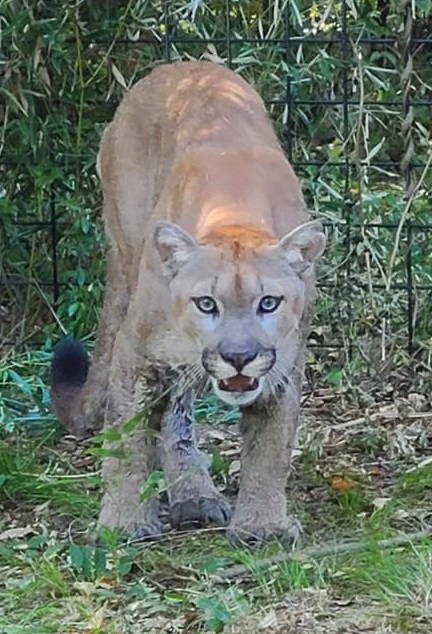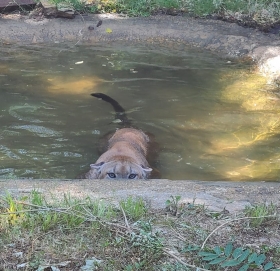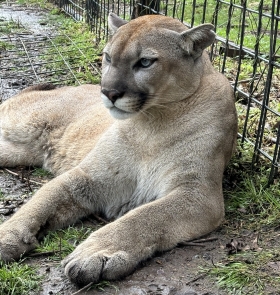
Mountain Lion (Cougar)
Puma concolor
Animal Behavior: Mountain lions are solitary animals, with the exception of 1 to 6 days of associations during mating and periods of juvenile dependence. Population densities vary from as low as one individual per 85 square kilometers to as high as one per 13 to 54 square kilometers, depending on the density of prey and other resources in the area. Females with dependent cubs live within the wide space used by the resident male. Mountain lions mark their territories by depositing urine or fecal materials by trees marked with scrapes. Mountain lions are primarily nocturnal. Males are found together immediately after leaving their mother, but rarely as established adults. Mountain lions have summer and winter home ranges in some areas, requiring a migration between ranges.
Home ranges of females range from 26 to 350 square kilometers, with an average of 140 square kilometers. Female home ranges may overlap extensively. Male home ranges do not overlap with those of other males and typically encompass the home ranges of two females. They range in size from 140 to 760 square kilometers, with an average of 280 square kilometers..
Eating Habits: Mountain lions are carnivores. Their main prey throughout their range are different species of ungulates, including moose, elk, white-tailed deer, mule deer, and caribou in North America. They will also eat smaller creatures like squirrels, muskrat, porcupine, beaver, raccoon, striped skunk, coyote, bobcats, other mountain lions, rabbits, opossums, birds, and even snails and fish. They may also prey on domestic livestock, including poultry, calves, sheep, goats, and pigs. Mountain lions have a distinctive manner of hunting larger prey. The lion quietly stalks the prey animals, then leaps at close range onto their back and breaks the animal's neck with a powerful bite below the base of the skull. Yearly food consumption is between 860 to 1,300 kg of large prey animals, about 48 ungulates per lion per year. Mountain lions cache large prey, dragging it up to 350 meters from the place of capture and burying it under leaves and debris. They return nightly to feed.
Range: Historically, mountain lions had the most extensive distribution of all American terrestrial mammals. They ranged from coast to coast in North America, and from southern Argentina and Chile to southeastern Alaska. Extermination efforts, hunting pressure, and habitat destruction have restricted their range to relatively mountainous, unpopulated areas throughout much of their range. Populations in eastern North America were entirely exterminated, except for a small population of Florida panthers (Puma concolor coryi). In recent years populations have begun to expand into areas of human habitation, especially in the western United States. Mountain lions are now fairly common in suburban areas of California and have recently been sighted as far east as urban Kansas City, Missouri, where several have been hit by cars. Mountain lion sightings in eastern North America, outside of southern Florida, are still more likely to be escaped or abandoned "pet" mountain lions or other large cats..
Conservation Efforts: Some subspecies are listed in CITES Appendix I all others are Appendix II. Some populations are listed as Endangered under the Endangered Species Act. Two populations listed as endangered under the Endangered Species Act are considered extinct (Puma concolor schorgeri and Puma concolor couguar). Puma concolor coryi, Florida panthers, and Puma concolor costaricensis are considered endangered and extant.
Animal Facts: Mountain lions may live up to 18 to 20 years in the wild. They can live slightly longer in captivity. Mountain lions rely mainly on vision, smell, and hearing. They use low-pitched hisses, growls, purrs, yowls, and screams in different circumstances. Loud, chirping whistles by young serves to call the mother. Touch is important in social bonding between mother and young. Scent marking is important in advertising territory boundaries and reproductive state.
References:
https://animaldiversity.org/accounts/Puma_concolor/


